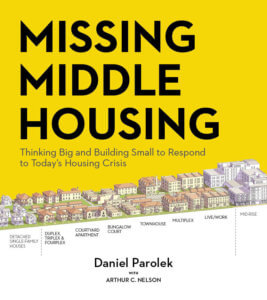|
5/3/2021 Book review: missing middle housing: Thinking big and building small to respond to today's housing crisisRead Now By Karen Swirsky, Board Member I can’t quite remember the first time I hear the term “Missing Middle Housing,” but I do recall being intrigued by the phrase. As I read about it, I came to understand that architect and author Dan Parolek had coined this term to mean the type of housing that I can find in any of Bend’s older, more charming neighborhoods – duplexes, townhouses, and small apartment buildings that easily co-exist with single family homes, ranging from modest to mansion. As a planner, I was aware that many of these other housing types had been banished to multi-family zones in our town, so that now you can find entire newer neighborhoods of double-garaged duplex homes. When I first became aware of Missing Middle Housing, it was mainly about form – and how to gracefully blend housing types such as courtyard apartments or fourplexes into all residential neighborhoods. And, of course, the Missing Middle Housing still is about form. However, recently, discussions of Missing Middle Housing have become as much about affordability as form, and the term Missing Middle seems to be used to as much describe affordable work-force housing as it is size and appearance. Even recent Oregon legislation uses the term in this way. So, I was glad to see that the new book, Missing Middle Housing: Thinking Big and Building Small to Respond to Today’s Housing Crisis, tackles this topic head on. As co-author Dr. Nelson points out, our changing demographics point to the need for a greater choice in housing types in all of our neighborhoods – something in between single-family houses on individual lots and large apartment complexes. For me, another descriptor for the communities Dan Parolek describes, beyond “missing” and “affordable” is “humane.” I imagine a city where an aging person can downsize and stay in their neighborhood, and where a person just starting out has a range of housing choices. This excellent book is written for those who are interested in the current housing crisis. It has some fairly technical sections that will appeal to the planning professional – but is cogently written and is worth buying just for the illustrations and examples. Activists, community leaders, and anyone who is solution-oriented will enjoy this book. Get the book >> Learn more about Daniel Parolek’s upcoming lecture for Building a Better Bend >>  Karen Swirsky is a Senior Planner with the City of Bend and has lived here since 1989 with her husband, Nils Eddy. She has both private and public land use experience. Karen has served on many state and local boards and committees, including the Oregon Bicycle and Pedestrian Advisory Committee, and is the main author of a national award-winning publication, Main Street, When a Highway Runs Through It. She has been a BBB board member for the last 8 years.
2 Comments
|
 RSS Feed
RSS Feed